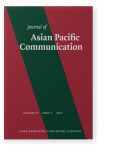Protest and protect
Chinese urban mothers’ perception of smartphone (tablet) in their everyday lives’ communication and interaction with young children
A phenomenological study reveals Chinese mothers’ perception and interpretation of smartphone (tablet) in their everyday communications and interactions with their young children. In total, 23 in-depth interviews were used to collect data. Data of the current study indicated that Chinese mothers’ perception of smartphone (tablet) in their everyday lives’ communication and interaction with young children is both grounded and reflective of their parenting philosophy and family communication style. Data of the current study indicated that today’s Chinese mothers have a mixed feeling toward the role of smartphone and tablet plays in their parenting practices. According to those participants, the smartphone and tablet both help and hurt their communications and interactions with their children. There are both direct and indirect benefits of using smartphone for parenting. Similarly, the smartphone (tablet) also hurts Chinese mothers’ communications and interactions with their children directly and indirectly.
Article outline
- Literature review
- Today’s Chinese Women
- Mobile communication and family
- Mobile phone and family communication
- Mobile phone and parenting
- Theoretical perspectives: apparatgeist, mediatization, and polymedia
- Methodology
- Findings
- Challenging orthodox – Chinese mothers’ parenting philosophy and family communication style
- Protesting and protecting – chinese mothers’ perception of smartphone (tablet)’s role in parenting
- Discussion
- Limitation and future research
-
References
This article is currently available as a sample article.
References (29)
Aleti, T., Brennan, L., & Parker, L.
(
2015)
Family communication for the modern era: a typology.
Young Consumers, 16(4), 367–384.


Attane, I.
(
2012)
Being a women in China today: A demography of gender.
China perspectives, 41, 5–15.


Bell, G.
(
2006)
The age of the thumb: A cultural reading of mobile technologies from Asia.
Knowledge, Technology, & Policy 19(2), 41–57.


Castells, M., Fernandez-Ardevol, M., Qiu, J. L., & Sey, A.
(
2007)
Mobile communication and society: A global perspective. Cambridge, MA: MIT Press.

Chao, R.
(
1994)
Beyond parental control and authoritarian parenting style: Understanding Chinese parenting through the cultural notion of training.
Child Development, 651, 1111–1119.

Chua, A.
(
2011)
Why Chinese Mothers are Superior.
The Wall Street Journal. Retrieved from
[URL]
Clark, L. S.
(
2013)
The parent app: Understanding families in the digital age. New York: Oxford University Press.

CNNIC
(
2015,
January).
Chinese Internet development report. Available at
[URL]
Corbin, J. & Strauss, A.
(
2008)
Basics of qualitative research (3rd ed.), Thousand Oaks, CA: Sage.

Crowe, R. & Middleton, C.
(
2012)
Women, smartphones and workplace: Pragmatic realities and performative identities.
Feminist Media Studies, 12(4), 560–569.

Dalsgaard, T., Skov, M.B., Stouggard, M., & Thomassen, B.
(
2006)
Mediated intimacy in families: Understanding the relation between children and parents.
IDC,
June 7–9, Tampere, Finland.


Devitt K. & Poker D.
(
2009)
The role of mobile phones in family communication.
Children & Society, 231, 189–202.


IPSOS
(
2011,
November).
Chinese smartphone market investigation. Available at
[URL]
Katz, J. E.
(
2006)
Magic in the air: Mobile communication and the transformation of social life. New Brunswick, NY: Transaction Publishers.

Kvale, S.
(
1983)
The qualitative research interview: A phenomenological and a hermeneutical mode of understanding.
Journal of Phenomenological Psychology, 14(2), 171–198.

Ling, R. & Donner, J.
(
2009)
Mobile communication. Malden, MA: Polity.

Madianou, M.
(
2014)
Smartphone as polymedia.
Journal of Computer-Mediated Communication, 19 (3), 667–680.


Madianou, M. & Miller, D.
(
2011)
Mobile phone parenting: Reconfiguring relationships between Filipina migrant mothers and their left-behind children.
New Media & Society, 13(3), 457–470.


Maxwell, J. A.
(
2013)
Qualitative research design: An interactive approach (3rd ed.). Thousand Oaks, CA: Sage.

McCracken, G.
(
1988)
The Long Interview. Newbury Park, CA: Sage.


Moran, D.
(
2000)
Introduction to phenomenology. New York, NY: Routledge.

Moustakas, C.
(
1994)
Phenomenological research methods. Thousand Oaks, CA: Sage.


Palen, L. & Hughes, A.
(
2007)
When home base is not a place: Parents’ use of mobile phones.
Journal of Personal & Ubiquitous Computer, 11(5): 339–348.


Rakow, L. F., & Navarro, V.
(
1993)
Remote mothering and the parallel shift: Women meet the cellular telephone.
Critical Studies in Mass Communication, 101, 144–157.


Smith, J., Flowers, P., & Larkin, M.
(
2009)
Interpretative phenomenological analysis: Theory, method and research. Los Angeles, CA: Sage.

Thompson, C., Locander, W., & Pollio, H.
(
1990)
The lived meaning of free choice: An existential-phenomenological description of everyday consumer experiences of contemporary married women.
Journal of Consumer Research, 171, 346–361.


Uy-Tioco, C.
(
2012)
Overseas Filipino workers and text messaging: Reinventing transitional mothering.
Continuum: Journal of Media & Cultural Studies, 21(2), 255–265.

Weisskirch, R. S.
(
2009)
Parenting by cellphone: Parental monitoring of adolescents and family relations.
Journal of Youth Adolescence, 381, 1123–1139.


Wu, A.
(
2016,
April).
Basic situation of Chinese women. Available at
[URL]
Cited by (2)
Cited by 2 other publications
Ewin, Carrie A., Andrea E. Reupert, Louise A. McLean & Christopher J. Ewin
2021.
The impact of joint media engagement on
parent–child
interactions: A systematic review
.
Human Behavior and Emerging Technologies 3:2
► pp. 230 ff.

Lee, Yoon-Joo & Huan Chen
2018.
Empowerment or alienation: Chinese and Korean immigrant mothers’ perception of mobile media in constructing their social role and facilitating parenting practices in the US.
Mobile Media & Communication 6:3
► pp. 390 ff.

This list is based on CrossRef data as of 4 july 2024. Please note that it may not be complete. Sources presented here have been supplied by the respective publishers.
Any errors therein should be reported to them.
